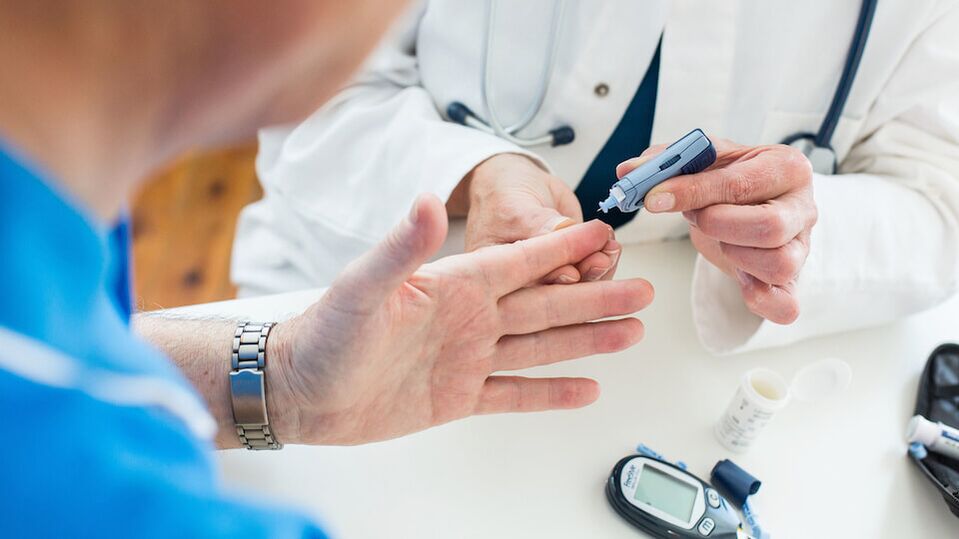Diabetes is a chronic endocrine disease that occurs in people with insulin resistance and pancreatic dysfunction. with persistent hyperglycemia. The patient is often thirsty and complains of frequent emptying of the bladder. The disease is based on the lack of own insulin on the background of elevated glucose levels. In the context of diabetes, appetite is often disrupted, overall health deteriorates, and wounds and ulcers heal poorly. The disease is chronic and characterized by continuous progression. Lack of treatment is rife with strokes, kidney failure, heart attacks, and significant vision loss. Rapid blood sugar fluctuations can lead to hyperglycemia or hypoglycemia coma.
symptom

Diabetes develops gradually, and there may be no specific symptoms in the early stages. Often, violations are discovered by chance during the next scheduled inspection.
The progression of the disease leads to complaints of:
- thirst and dry mouth
- Insomnia
- lower extremity cramps
- itchy skin
- Disability
- Decreased emotional instability
- heavy and frequent urination
- increased appetite
- Dry, cracked, ulcerative lesions of the skin and mucous membranes
- Vision loss.
The regeneration process is slowed down: wounds, ulcers, wounds heal for a long time. The sensitivity of the legs decreases until complete numbness. The progression of obesity is possible. As the disease progresses, the hair on the legs begins to fall out, while the hairiness of the facial skin may increase. Xanthomas form on the body - small yellow formations.
The genitourinary system is often affected: women are often diagnosed with vulvovaginitis, balanoposthitis in women. Metabolic processes are disturbed, defenses are reduced, and the body's resistance to infectious lesions is reduced. Long-term lack of medical care can lead to osteoporosis. This is accompanied by complaints of pain in the joints and spine, deformation of the bones and destruction of their integrity.
reason
Diabetes is accompanied by tissue insulin resistance. This means they become less sensitive to the effects of insulin. At the same time, the insulin level in the plasma often remains within the normal range, and the blood glucose level increases significantly. The disease is usually diagnosed in older patients.
Among the triggering factors leading to violations are:
- genetic predisposition
- nutritional errors
- Cardiovascular diseases
- chronic stress
- adrenal insufficiency
- excess weight
Diabetes can develop on the background of long-term use of certain medications.
Insulin resistance
Insulin resistance is a pathological condition that underlies the mechanism of diabetes development. In vivo, tissues are less sensitive to the action of insulin. There may be no specific symptoms. The violation was accompanied by excess body weight and increased blood pressure.
In patients, the progression of hepatic fatty liver disease is noted, and areas of hyperpigmentation may form on the skin: acanthosis nigricans. To identify violations, it is necessary to perform blood tests for blood glucose, insulin, and check the HOMA index. Treatment is based on dietary correction, moderate physical activity.
overweight

People who are overweight are at risk: adipose tissue can hinder tissue sensitivity to the action of insulin. This is one of the key factors in the development of the disease. Over 89% of people with diabetes are found to be overweight. Reasons for such irregularities may be maintaining a sedentary lifestyle, genetic predispositions, metabolic disorders. Medical correction is required, psychological state research is required, and appropriate diet is selected.
pancreatic tumor
Pancreatic tumors can trigger diabetes in people of different ages. Usually, these tumors are benign and don't cause specific symptoms until they get bigger. Lack of timely treatment can lead to the transformation of benign tumors into malignant tumors. At the same time, symptoms of systemic poisoning appeared, compression of peripheral organs, and damage to blood vessels and nerve endings were observed.
To confirm the diagnosis, the following diagnostic studies are involved:
- Tumor markers
- CT scan
- Magnetic resonance imaging
- prick
- biopsy
Treatment options are selected individually. In most cases, surgery is required. With the malignancy of the pathological process, the course of chemotherapy and radiation therapy is additionally prescribed.
sedentary lifestyle
Mitochondria, the energy stations of every cell in the body, suffer from a lack of motor activity. This can lead to disruption of internal organ function, worsening mood and a tendency to depression. Many people with diabetes tend to seize on stress and rarely participate in exercise. Even 15 minutes of exercise a day can activate metabolic processes, increase the sensitivity of cells to insulin and reduce the risk of diabetes. If daily practice is not possible, show a quick hike in fresh air. It is recommended to walk and breathe fresh air for at least half an hour every day.
Cardiovascular diseases
Under the influence of cardiovascular disease, tissue sensitivity to insulin decreases and the risk of developing diabetes increases.
People diagnosed with such disorders should exercise the utmost vigilance:
- atherosclerosis
- arterial hypertension
- Coronary artery disease.
IHD is a type of cardiomyopathy that occurs when the blood supply to the heart muscle is insufficient. It is the most common cause of death, over 75%. Most common in patients with hypertension, hyperlipidemia, fatigue, obesity, and smokers. It is important that the underlying cause of the disease is treated promptly and checked regularly by a cardiologist.
Improper nutrition

An important factor is the diet of diabetics. They are prone to overeating and nutritional deficiencies. They often lack essential substances like:
- Minerals, including chromium, selenium, manganese, iron, zinc, copper
- Polyunsaturated fatty acids – healthy fats found in wild fish, ghee, high quality cold-pressed vegetable oils
- proteins, which are the building blocks of new cells and tissues
- Fat-soluble substances: vitamins A, E, D.
Diets are often dominated by simple carbohydrates and sugars, which can negatively impact gut flora and reduce the body's protective properties. If excess sugar and carbohydrates get into the body, it can cause a glucose surge and overload the pancreas.
endocrine disease
Diabetes can develop in the context of endocrine diseases:
- pancreatitis
- pituitary failure
- Hypothyroidism
- Hyperthyroidism
- Thyrotoxicosis
- Adrenal dysfunction.
In this case, it needs to have a complex impact on the underlying causes of diabetes. Patients often take hormonal medications: either in courses or on a regular basis. It is also important to eliminate stressors and normalize sleep. It is important to ensure adequate intake of iodine, selenium, zinc and iron to ensure proper functioning of the endocrine glands.
infectious disease
Manifestations of diabetes are often observed in conjunction with chronically progressive infectious diseases:
- herpes
- viral hepatitis
- herpes
Chronic infections deplete the body's defenses, making it more susceptible to other diseases. The main manifestation of hepatitis may be a symptom of a viral disease. In this case, it is important to address the root cause - the source of the infection and reduce the viral load on the body. To do this, use antiviral drugs, immunostimulants, symptom-modifying drugs.
drug
Certain drug groups can also cause manifestations of diabetes in the elderly or middle-aged.
The risk group includes people who:
- Synthetic corticosteroids
- Diuretics
- cytostatic
Medication should only be taken as prescribed by your doctor. If the medication is causing insulin resistance and increasing the risk of diabetes, it is recommended to reconsider the appointment, adjust the dose, and choose an alternative to replace it. It is not possible to prescribe or stop taking the drug yourself, as this may aggravate the course of the underlying disease, treatment with the described drugs is recommended.
chronic adrenal insufficiency
Adrenal insufficiency often leads to the development of diabetes. It occurs in patients with insufficient secretion of adrenal hormones. Characteristic symptoms: Bronze pigmentation on skin, mucous membranes, weakness, vomiting, diarrhea, disturbance of consciousness. With water and electrolyte disturbances, cardiovascular system dysfunction. Treatment is carried out in a complex manner: elimination of the underlying cause, use of corticosteroids, symptomatic drugs.
possible complications

Untreated diabetes is fraught with complications such as:
- Diabetic vascular disease - increased vascular permeability, increased risk of thrombosis, cardiovascular disease.
- Diabetic foot - occurs in the context of lower extremity circulatory disturbances.
- Nutritional ulcer of lower extremity.
- Diabetic polyneuropathy is a disease that affects peripheral nerves and occurs in more than 70% of people with diabetes. Over time, polyneuropathy can turn into neuropathy. This complication is rare but requires prompt, high-quality medical care.
- Diabetic nephropathy, in which it damages the blood supply to the blood vessels of the kidneys and increases the likelihood of developing kidney failure.
- Diabetic coma is the most dangerous complication and can lead to death.
Hyperglycemia occurs when blood sugar increases significantly. This is accompanied by weakness, general malaise, loss of appetite, and headache. If proper measures are not taken, the patient begins to feel nauseated and the vomit smells of acetone. Relieve abdominal pain and lower blood pressure. In order to prevent dangerous complications, it is important to start treatment for insulin resistance/diabetes promptly and to monitor blood sugar levels continuously. It is impossible to choose the drugs yourself, because they may not have the proper therapeutic effect and cause complications.
which doctor to contact
At the first symptoms of diabetes, consultation with an endocrinologist is recommended. Doctors will use laboratory and instrumental techniques to conduct a comprehensive diagnosis to determine how advanced the disease is. In the future, other doctors may need to be consulted: cardiologist, nutritionist, oncologist, gynecologist. It is important to follow all directions from your doctor and avoid self-medicating.
diagnosis

To confirm the diagnosis, doctors prescribe a comprehensive diagnosis:
- fasting blood sugar
- Ketone bodies and sugars in urine
- Glycated hemoglobin
- C-peptide
- insulin
- Glucose tolerance test.
To determine the sugar in the urine, special test strips are used. For timely detection of diabetic complications, renal ultrasonography, extremity angiography, and examination of the structural and functional state of the brain are recommended.
treat
Treatment options are selected individually for each patient. At the same time, age and accompanying chronic physical diseases are taken into account. Treatment is lifelong and patients must be under the continuous supervision of an endocrinologist. In the first phase, they reviewed the diet and reduced the number of meals.
It is best to have two meals a day and no snacks. Breakfast contains healthy fats, proteins, carbohydrates, which can be obtained from vegetables. Baked products, sugar and other sources of simple carbohydrates are completely eliminated from the diet. Portions are small and provide satiety thanks to balanced ingredients and the presence of fat.
Medication correction involves the use of such drugs:
- Hypoglycemic agents
- Medications to restore blood circulation and microcirculation
- High blood pressure medication (if needed)
Treatment regimens are selected individually, usually supplemented with vitamin-mineral complexes, amino acids: taurine, glycine. Medications will not help eliminate the problem completely. Patients are asked to make responsible lifestyle changes and follow all physician recommendations.
Diabetics exhibit moderate physical activity. This avoids further progression of the pathological process and the development of complications. Daily walking, yoga, swimming, gymnastics, breathing exercises are recommended. The best option - take classes under the supervision of a tutor. It is advisable to discuss the load with your doctor in advance.
prevention

To prevent diabetes, it is important to monitor your diet, normalize your weight, eliminate stressors, and return to work, rest, and sleep patterns. It is important to review your diet, including adequate amounts of healthy fats, fiber, and reducing simple carbohydrates. Restoring sleep is important: go to bed no later than 23: 00 and sleep in a dark, cool room.
Pay special attention to physical activity: daily walks in fresh air, running, brisk walking, swimming, and any other type of physical activity that is appropriate and feasible. Physical inactivity is unacceptable and exacerbates the progression of insulin resistance. Breathing exercises are useful: Pranayama, Buteyko breathing, to ensure adequate supply of oxygen to the tissues.
It is recommended to monitor the indicators of glucose, glycated hemoglobin, and insulin in the population and risk groups. At the first sign of a violation, refuse to self-medicate and seek help from an experienced endocrinologist.
Most patients who seek prompt medical help and make lifestyle changes have a good prognosis. They can live long, quality lives without facing the dangerous complications of the disease. Lack of treatment can lead to reduced life expectancy and acute/chronic complications.

























